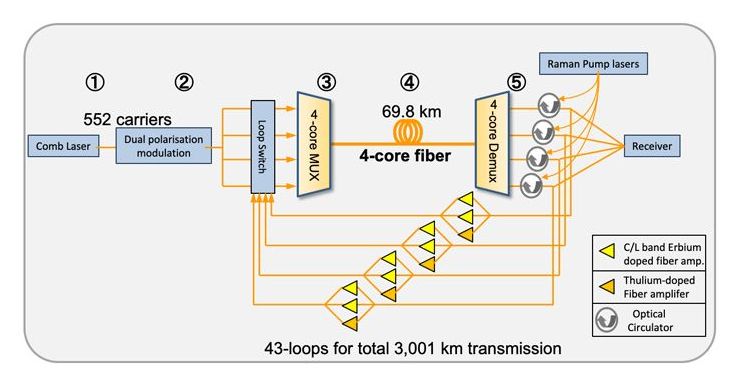Researchers in Tokyo, Japan, have achieved a data rate of 319 terabits per second (Tbit/s) over a distance of 3001 km (1865 mi).



The canisters can’t stay on the 11-acre storage site on Bailey Peninsula in Wiscasset forever. And the specter of climate change and ocean level rise adds urgency to the hunt for a solution.
That’s a problem because the waste — 1400 spent nuclear fuel rods housed in 60 cement and steel canisters, plus four canisters of irradiated steel removed from the nuclear reactor when it was taken down — is safe for now, but can’t stay in Wiscasset forever.
The situation in Wiscasset underscores a thorny issue facing more than 100 communities across the U.S.: close to a hundred thousand tons of nuclear waste that has no place to go.
Securing these remnants of nuclear energy generation is an ongoing task that requires armed guards around the clock and costs Maine Yankee’s owners some $10 million per year, which is being paid for with money from the government.

NYU Abu Dhabi (NYUAD) researchers have uncovered a code that sets the genome of the liver to account for the remarkable ability for this organ to regenerate. This finding offers new insight into how the specific genes that promote regeneration can be activated when part of the liver is removed. These findings have the potential to inform the development of a new form of regenerative medicine that could help non-regenerative organs regrow in mice and humans.
While other animals can regenerate most organs, humans, mice, and other mammals can only regenerate their liver in response to an injury or when a piece is removed. NYUAD researchers hypothesized that the genes that drive regeneration in the liver would be controlled by a specific code that allows them to be activated in response to injury or resection. They home in on the epigenome, which is the modifications on the DNA that alter the gene expression, as opposed to changing the genetic code itself.
Using a mouse liver model, the team of NYUAD researchers, led by Professor of Biology Kirsten Sadler Edepli, identified the elements of the epigenetic code present in quiescent liver cells—cells that are currently not replicating but have the ability to proliferate under the right conditions—that activate specific genes to regenerate. Genes involved in liver cell proliferation are silenced in livers that are not regenerating, but the surprising finding was that they reside in parts of the genome where most genes are active. The researchers found that these pro-regenerative genes were marked with a specific modification—H3K27me3. During regeneration, H3K27me3 is depleted from these genes, enabling their dynamic expression and driving proliferation.

An international team anchored by the Event Horizon Telescope (EHT) Collaboration, which is known for capturing the first image of a black hole in the galaxy Messier 87, has now imaged the heart of the nearby radio galaxy Centaurus A in unprecedented detail. The astronomers pinpoint the location of the central supermassive black hole and reveal how a gigantic jet is being born. Most remarkably, only the outer edges of the jet seem to emit radiation, which challenges our theoretical models of jets. This work, led by Michael Janssen from the Max Planck Institute for Radio Astronomy in Bonn and Radboud University Nijmegen is published in Nature Astronomy today (July 19th, 2021).
At radio wavelengths, Centaurus A emerges as one of the largest and brightest objects in the night sky. After it was identified as one of the first known extragalactic radio sources in 1949, Centaurus A has been studied extensively across the entire electromagnetic spectrum by a variety of radio, infrared, optical, X-ray, and gamma-ray observatories. At the center of Centaurus A lies a black hole with the mass of 55 million suns, which is right between the mass scales of the Messier 87 black hole (six and a half billion suns) and the one in the center of our own galaxy (about four million suns).


Following the success in 2019 of Bill Nye and the Planetary Society’s solar sail craft LightSail 2, NASA plans to launch its own solar sail project to investigate near-Earth asteroids.
The Near-Earth Asteroid Scout (NEA Scout) is a small satellite around the size of a shoebox that will sail through space powered by sunlight. The hardware will consist of a stainless steel boom structure across which a thin, aluminum-coated plastic sail will be stretched. The total area covered by the sail is around that of a racquetball court, and as photons from the sun bounce off the shiny surface, they will propel the craft forward.
As wacky as this idea sounds — it was made famous by, among others, science fiction author Arthur C. Clarke — it has been shown to work in low-Earth orbit by the LightSail project. Now NASA will take this one step further by deploying a solar sail in deep space.


“Gorgon’s failure poses a major problem for any oil and gas company betting on CCS to meet net zero,” said Ian Porter, the chairperson of Sustainable Energy Now, WA. “CCS simply does not work at the scale and at the price needed.”
(Bloomberg) — The world’s biggest project to capture and store carbon dioxide isn’t working like it should, highlighting the challenges oil companies face in tackling their greenhouse gas emissions. Chevron Corp.’s system at the $54 billion Gorgon liquefied natural gas export plant in Australi…


CHINA’S NEW THORIUM-BASED NUCLEAR REACTOR is well situated for being adopted for Space applications.
China is slowly but steadily positioning itself to leap ahead of the US Space program. It is doing this without pomp and fanfare, and without the idea of a “space race,” simply based upon what it requires for its future.
1) Recent noteworthy progress on molten salt thorium reactors could be a key component of future Chinese space-worthiness. Originally designed by the USA’s Oak Ridge National Laboratory in the 1960’s, they were planned to be used for nuclear powered strategic bomber planes, before the nuclear submarine concept became adopted as more feasible. They were chosen because they can be miniaturized to the size of an aircraft. By the same token, they could conceivably be used in advanced atmospheric or space propulsion.
2) Recently, China announced successful tests on a new type of aircraft that takes in air from the surrounding atmosphere, ionizes it with electricity, and expels it as exhaust. The only thing needed would be a strong enough on-board electrical supply to supply the huge amount of power required. Only a nuclear power plant could supply that power unless it were to be beamed from ground stations. Such a plane would require no fuel for its entire lifetime. It could also function in any atmosphere, not only Earth’s atmosphere, since it is not based on burning fuel chemically, which requires oxygen. Versions of such air-plasma-breathing thrust could be used as part of the boosting phase of a rocket launch system.
3) A few days ago, China tested part of its fully reusable space plane, which is a vastly superior system to SpaceX’s “Starship” rocket. While Starship uses old-fashioned ballistic rocket technology, the Chinese spaceplane, according to reports that have come out, involves something similar to the Sanger space plane design. An early version of the Space Shuttle design also had this configuration. Instead of the Space Shuttle’s dangerous solid rocket boosters on the side, and its external fuel tank, which is dumped once the fuel is used up, such systems have a second “booster aircraft” which glides to a runway after boosting the upper stage orbiter into its atmospheric launch position. So, there are two vehicles which land on a runway, with only the orbiter going into space. In addition to this, the Chinese are adding “combined cycle” technologies, where more than one type of propulsion is being used on the aircraft. So, perhaps turbojets, and scramjets, and rocket engines will be used as one example of such a configuration.
The new molten salt reactors, part of a program developed under the leadership of former Chinese President Zemin’s son, and with collaboration from the US’s Oakridge National Laboratory, is now close to implementation stage. Such reactors could be integrated into a space plane, allowing “single-stage-to-orbit” concepts to become within reach. Such systems would not need a booster phase, but would use a combination of air-plasma-breathing and rocket engines to get to orbit with only a single vehicle, while landing like the Space Shuttle did or perhaps landing with powered flight instead of gliding without fuel as did the Shuttle.
All of this makes China’s plan for “nuclear-powered space shuttles” in the 2040’s very possible. If fusion power is obtained before then, this will all proceed even faster, and all the technical and engineering skills will be immediately brought to bear.